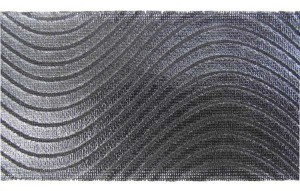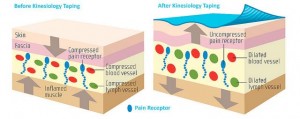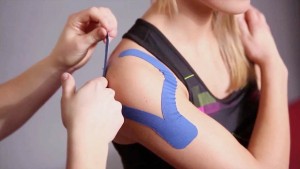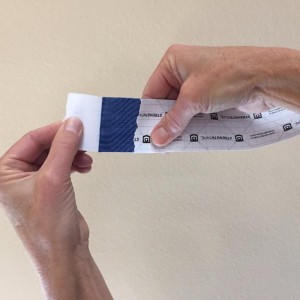Kinesiology tape is often seen in the high calibre sports world, however, you don’t need to be an Olympic athlete to experience the benefits of k-taping.
Since starting my practicum placement here at Pivotal Physiotherapy, I have had the opportunity to watch many of the therapists use this taping technique and have even had the opportunity to try a little taping for myself.
I’ve presented here a little bit on the history, some perceived benefits and some advice on how to begin taping for yourself.
HISTORY BEHIND KINESIOLOGY TAPING
Although Kinesio taping has only become popular in recent years, this taping technique has been around since the 1970s when it was introduced by a Japanese Chiropractor by the name of Dr. Kenzo Kase. (1,4, 9,11) Since this time Dr. Kenzo Kase has spread his technique worldwide for the treatment of clinical populations, athletes and even equine athletes.
DIFFERENCE BETWEEN KINESIO TAPING AND TRADITIONAL ATHLETIC TAPING
The vision behind the kinesio taping system was to design a tape and taping style which would effectively provide support to muscles and reduce pain while maintaining functional range of motion. The stretchy elastic nature of kinesio tape effectively serves this purpose. In contrast, regular athletic tape is far more rigid and does not stretch to allow unrestricted movement, it serves more to stabilize and immobilize joints following injuries. (1,3,4)
Another significant difference between kinesio tape and athletic tape is the length of time which the tape can be worn. Kinesio tape once applied, can be left on while bathing and participating in sports activities, its water resistant nature allows it to be worn for a period of 3-5 days. (1,3,4) Athletic tape is generally worn for an exercise session and then removed. (2,4)
BENEFITS OF KINESIOLOGY TAPING- WHAT DOES RESEARCH SAY?
While the science behind kinesio taping is still under investigation, Dr. Kenzo Kase the founder of the kinesio taping method believes the stretchy nature of the tape and its wavy adhesive pattern primarily contribute to the benefits seen with this taping style.
Once the tape is stretched and placed over the skin, it recoils slightly creating small folds in the skin which are thought to lift and separate the skin slightly from deeper tissue. This lifting effect is thought to eliminate compression on pain receptors, blood and lymph vessels allowing the vessels to open. This is thought to enhance blood flow and movement of lymph fluid and also decrease pressure on pain receptors in the deeper tissues to reduce sensations of pain while positioning joints and tissues in a desired position. (1,3,4,8,9)
While some studies report benefits of kinesio taping, others refute any positive effect kinesio taping may have. (1) It is evident that further research is needed to truly determine the role of Kinesio tape in patient rehab. The greatest results in favour of kinesio taping have involved mainly case studies in which one individual is examined for changes before and after kinesio taping treatment.
It should be noted that Kinesio taping is not a stand-alone method of treating sports injuries and should not be used as an only resort for the treatment of an injury. In conjunction with physical therapy and exercise, however, kinesio taping may be beneficial.
In several research studies, workers with rounded shoulder posture were shown to have reductions in pain and poor posture following shoulder taping using Kinesio tape. (6, 7) Additionally, some evidence exists indicating that kinesio taping aides in reducing the improper positioning of the knee once muscular fatigue has set in. (5) In essence, the taping helps to give an individual greater awareness of their body positioning with the tape serving as a guide for the proper positioning of the joint etc.
TAPING TECHNIQUES
Contrary to what you may think, there is not simply one way/method to taping injuries. In fact, the taping and even the shape of tape strips is dependent on the type of injury, the benefit you are trying to achieve, and the professional applying the tape. Want to learn how to prepare your own tape strips? Click here for a quick tutorial https://www.youtube.com/watch?v=v7HKeFoZraY
In kinesio taping, 6 corrective application techniques exist: (8)
“Recoiling” – uses the stretch of the tape to give feedback on body positioning.
“Holding” – aims to align tissue in a desired position.
“Lifting” – aims to reduce compression of blood vessels, lymph vessels and pain receptors to increase blood flow, reduce swelling, and reduce pain.
“Pressure” – aims at increasing the stimulation of tissues over a ligament or tendon.
“Spring” – used to assist or limit motion around a joint.
“Channelling” – used to decrease pressure over lymph ducts to create channels for lymph flow.
KINESIO TAPE APPLICATION
Want to learn the basics of kinesio tape application? Click here for a quick tutorial https://www.youtube.com/watch?v=cnjRu-NLIhU
When applying Kinesio tape to the skin’s surface it is important to ensure: (4,8)
1) The skin is clean. Body lotions or sprays which may prevent the tape from sticking, have been washed off.
2) All the ends of the kinesio tape have been rounded to avoid catching/peeling of the tape. This will cause a reduced length of time that the tape can effectively stick to the skin.
3) The paper backing is only removed from specific portions of tape which is placed on the skin first. These small sections of the tape first placed onto the skin are called “achors” and generally have no stretch applied through them.
4) Position the individual’s bodies appropriately so the muscles being taped are put in a stretch.
5) Remove the rest of the backing as the tape rolls down the skin and apply the appropriate stretch to the tape with no stretch through the anchor and no stretch through the final inch of the tape (tail).
6) Once the tape has been applied to the skin, rub over the tape with your fingers. This friction and heat will help activate the adhesive to ensure the tape is adequately stuck to the skin.
For point #3: Anchor pictured below
**** When kinesio taping, putting too much stretch through the tape can cause the tape job to become ineffective or irritate the patient. It is better to have too little stretch than too much****
KINESIO TAPE REMOVAL
Removing tape from the skin is not always a comfortable experience. Here are some tips to minimize discomfort: (4, 8)
1) Pull the tape off in the direction which your hair grows to eliminate the “waxing” effect this tape might otherwise have. (A general rule is to start peeling the end of tape from the top down)
2) Pull in slow tugs rather than ripping the tape off all at once.
3) Place a finger on the surface of the skin as an anchor to hold the skin down when pulling off the tape.
WANT TO TAPE? HERE ARE SOME QUICK AND HELPFUL INSTRUCTIONAL VIDEOS:
Shoulder Tape for Impingement or Rotator Cuff Strain: https://www.youtube.com/watch?v=iALHccCnR4k
Knee Pain: https://www.youtube.com/watch?v=SDB2WR9ijcs
Ankle Sprain support: https://www.youtube.com/watch?v=Xnpy0_S5RNM https://www.youtube.com/watch?v=fmhtXbI1zrA
Low Back pain/ Disc Degeneration/Herniation: https://www.youtube.com/watch?v=Xa_FSj46i94
Nicole Geier BScKin Student
REFERENCES
1 Artioli, D.P. & Bertolini, G.R.F. (2014). Kinesio taping: Application and results on pain: systematic review. Fisioter Pesq, 21(1). 94-99.
2 Bandyopadhyay, A. & Mahapatra, D. (2012). Taping in sports: A brief update. J. Hum. Sport Exerc., 7(2). 544-552.
3 Coker, P. (2012). Kinesiology Tape: The low down. SportEx dynamics, 32(1). 7-9.
4 Gibbons, J. (2014).Kinesiology Taping: The brightly coloured tape that’s making a big statement. SportEX dynamics, 41(1). 8-12.
5 Han, J.T. & Lee, J-H. (2014). Effects of Kinesiology Taping on Repositioning Error of the Knee Joint after Quadriceps Muscle Fatigue. J. Phys. Ther. Sci., 26(1). 921–923.
6 Han, J-T., Lee J-H. & Yoon, C-H. (2015).The mechanical effect of kinesiology tape on rounded shoulder posture in seated male workers: a single-blinded randomized controlled pilot study. Physiotherapy Theory and Practice, 31(2). 120-125.
7 Hwang-Boa, G., Leeb, J-H. & Kimc, H-D. (2013). Efficacy of kinesiology taping for recovery of dominant upper back pain in female sedentary worker having a rounded shoulder posture. Technology and Healthcare, 21(1). 607-612.
8 Kase, K., Wallis, J. & Kase, T. (2003) Clinical Therapeutic Applications of the Kinesio Taping Method 2nd edition. Kinesio Taping Association.
9 Moore, R. (2012). What is the current evidence for the use of Kinesio Tape? A Literature Review. SportEx dynamics, 34(1). 24-30.
10 Morris, D., Jones, D., Ryan, H., & Ryan, C.G. (2013). The clinical effects of KinesioTex taping: A systematic review. Physiotherapy Theory and Practice, 29(4). 259-270.
11 Williams, S., Whatman, C., Hume, P. A. & Sheerin, K. (2012).Kinesio Taping in Treatment and Prevention of Sports Injuries: A Meta-Analysis of the evidence for its effectiveness. Sports Med, 42(2). 153-164.
FIGURE REFERENCES
Figure 1 & 2. Retrieved from: http://chirocentre.co.uk/kinesio-tape-coloured-tapingathletes-sport-injury/
Figure 3. Retrieved from: http://www.ultimate-performance.co.uk/images/uploads/ktape %20wave%20pattern.jpg
Figure 4. Retrieved from: http://advancedhealth.ca/clients/516/images/ Before_and_after_kinesio_tape.jpg
Figure 5. Retrieved from: http://i.ytimg.com/vi/jAO09YlYA6I/maxresdefault.jpg
Figure 6. Retrieved from: http://www.athletictapeinfo.com/wp-content/uploads/2010/10/ powerstrips-front-back.jpg
Figure 7. Retrieved from: http://www.theratape.com/education-center/wp-content/ uploads/2015/03/step2-remove-anchor-end-backing.jpg
Figure 8. Retrieved from: https://fbcdn-sphotos-b-a.akamaihd.net/hphotos-ak-xap1/v/ t1.0-9/s552x414/10329100_10152956175646241_918542524645348151_n.jpg? oh=bbab79ec52a44283e26e7fdc8a5a53fd&oe=55260572&__gda__=1428705354_b27f 33e09a51de9632c325bcf0e7befe








